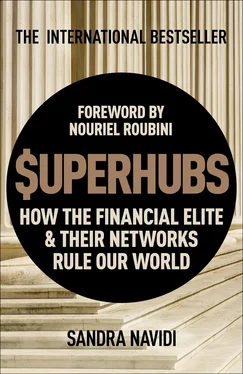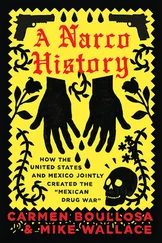Sandra Navidi - SuperHubs - How the Financial Elite and Their Networks Rule our World
Здесь есть возможность читать онлайн «Sandra Navidi - SuperHubs - How the Financial Elite and Their Networks Rule our World» весь текст электронной книги совершенно бесплатно (целиком полную версию без сокращений). В некоторых случаях можно слушать аудио, скачать через торрент в формате fb2 и присутствует краткое содержание. Год выпуска: 2017, Издательство: Hodder & Stoughton, Жанр: Старинная литература, на английском языке. Описание произведения, (предисловие) а так же отзывы посетителей доступны на портале библиотеки ЛибКат.
- Название:SuperHubs: How the Financial Elite and Their Networks Rule our World
- Автор:
- Издательство:Hodder & Stoughton
- Жанр:
- Год:2017
- ISBN:нет данных
- Рейтинг книги:4 / 5. Голосов: 1
-
Избранное:Добавить в избранное
- Отзывы:
-
Ваша оценка:
- 80
- 1
- 2
- 3
- 4
- 5
SuperHubs: How the Financial Elite and Their Networks Rule our World: краткое содержание, описание и аннотация
Предлагаем к чтению аннотацию, описание, краткое содержание или предисловие (зависит от того, что написал сам автор книги «SuperHubs: How the Financial Elite and Their Networks Rule our World»). Если вы не нашли необходимую информацию о книге — напишите в комментариях, мы постараемся отыскать её.
SuperHubs: How the Financial Elite and Their Networks Rule our World — читать онлайн бесплатно полную книгу (весь текст) целиком
Ниже представлен текст книги, разбитый по страницам. Система сохранения места последней прочитанной страницы, позволяет с удобством читать онлайн бесплатно книгу «SuperHubs: How the Financial Elite and Their Networks Rule our World», без необходимости каждый раз заново искать на чём Вы остановились. Поставьте закладку, и сможете в любой момент перейти на страницу, на которой закончили чтение.
Интервал:
Закладка:
Being a well-known philanthropist has given Soros access and helped his business, although he argues that he does not need philanthropy for business purposes and, quite to the contrary, worries that it may cloud his judgment.3 What George Soros does understand is the importance of creating a vast network of personal relationships, which is what has helped catapult him into the realm of the financial elite, and has made him a “superhub.”
A BLUEPRINT FOR NETWORKS: NODES, HUBS, AND SUPERHUBS — BANKERS, EXECUTIVES, AND CEOS
We all have an idea of what it takes to be successful: Get an education, work hard, and network. There are plenty of successful people in the world, but only a few become so disproportionately successful that they operate the very levers of the financial system. This extreme power concentration has given rise to conspiracy theories. However, it is not a nefarious plot that launches people into these places of power but instead laws of nature—as network science has proven. Network science helps us trace the formation of these elite networks and understand what it takes to become a highly connected and powerful nucleus, or “superhub.”
Networks govern every area of human activity—social, economic, or political—and all aspects of our lives are interrelated via these overlapping webs.4 Our financial system is simply one of those networks. When humans began settling into communities, they devised norms of exchanging labor and goods; with these, the network economy was born including the beginnings of financial systems.
Even before we are born, we are attached. As we grow, we are driven to connect in order to survive and thrive. Our fates are determined by the place we occupy within networks. While one person’s network may be limited in reach, it indirectly provides almost infinite exposure through its connections to other networks. I’m sure you’ve heard of the six degrees of separation theory, according to which every person on this planet can be connected to any other person by an average of six links. It was popularized by social psychologist Stanley Milgram in 1967 to prove that the world was in effect quite “small,” and later by John Guare in a play with the same name.5
All networks, regardless of whether they are natural or man-made, have the same underlying architecture: individual nodes connected via links, or pathways. Each node is a component of the network. It could be a neuron or an electrical substation or a person, like George Soros, for example. Nodes “always compete for connections because links represent survival in an interconnected world.”6 In human relationships, those links are the connections between two people and what they are based on: business deals and the exchange of information and favors.
In every network, the nodes exist in a hierarchy: The majority of nodes have only a few connections. Some nodes, which have several connections are known as hubs.7 Only a select few nodes, the superhubs, have so many connections to other nodes, hubs, and superhubs that they are virtually connected to the entire network.8 Superhubs tend to break the standard rules of exposure. Rather than six degrees, for instance, human superhubs, with greater professional seniority or social stature, might be separated from any other human by only a few degrees.
In our global financial network, anyone who works in the financial sector represents a node. More senior people, for instance, who are well connected due to their position and corresponding station in life are hubs. They typically have many subordinates and a fair amount of influence within their institutions and communities. The superhubs are the people in the very center of the financial sector, like CEOs of major banks. They occupy central network positions and have a large number of quality relationships and connections across different networks.
Every network—be it the universe, an organism, or a financial network—has a natural tendency to expand. Expanding networks do not follow a normal distribution; nodes prefer attaching to other nodes that are already more connected, because the more links a node has, the greater its chances of survival. Thus, it is advantageous for one to be connected to a stronger, healthier, more robust node. As a result, a few nodes, so-called hubs, attract a disproportionate number of links and become central connections. This dynamic has been coined the “rich-get-richer” phenomenon, because in the competition for new connections, those who already have more, get more.9 (I explore this in more detail in Chapter 5.) According to physicist Albert-László Barabási, “If a node has twice as many links as another node, then it is twice as likely to receive a new link.”10 Thus, a few hubs—superhubs—will be connected to almost all nodes.11 This is called a “power-law distribution.” The behavior of a network is governed by the interactions between nodes, hubs, and superhubs. The interactions are primarily determined by the network’s purpose and to some degree by randomness.12 Due to power-laws, you can anticipate that the behavior of the network will be influenced by many nodes trying to create links to hubs and especially to superhubs. Thus, a few nodes, the superhubs, will have the most influence within the network, and their actions and interactions will have broad effects throughout the network. That is certainly true in our financial system.
Hubs can make networks more efficient by creating a high degree of connectivity, but they also tend to make networks more vulnerable. The failure of a hub can cascade through the network and cause a total system failure. An example is the electrical grid, which is so interconnected and sensitive that a single disturbance can travel through the system and cause failures thousands of miles away. Electricity is like blood in the human organism; without it, the system fails.13 In August 2003, several states in the United States experienced the largest blackout in American history. Office buildings were evacuated, 800 people had to be freed from elevators, failed traffic lights paralyzed transportation, and 350,000 subway passengers had to be rescued from dark tunnels. Hospitals had to switch to generators, and airports experienced grave disruptions due to rerouting, delays, and cancellations. More than seventy fires were reported. Nuclear plants automatically shut down, and telephone service was interrupted. No electronic equipment worked, and cash registers, ATMs, water supply systems, and even toilets were nonoperational. New York City emergency command operations were instituted to avoid looting, which had occurred in previous blackouts.14
Another example is the Lehman debacle, commonly considered to have been one of the triggers that caused the financial crisis to go global. The U.S. Treasury Department and Federal Reserve underestimated how intertwined Lehman was with other institutions around the world. When they announced that Lehman would not be bailed out, markets crashed and the global financial system came to a halt. Therefore, a network that consists of nodes with only a limited number of connections is more robust, because fewer connections will make it harder for failure to trigger a domino effect and spread. Our financial system consists of many human superhubs with high connectivity and is most definitely not immune to the failures of those with the greatest influence.
Financial Superhubs: Network Equals Networth
At the WEF in Davos—like everywhere else—Soros is in high demand. He hurries back and forth between the modernist Congress Centre and various quaint hotels at which meetings and sessions are held. As he makes his way through the crowd, he is continuously approached by people who either know or want to know him; not having the time to speak to everyone, he politely brushes off most of them.
Читать дальшеИнтервал:
Закладка:
Похожие книги на «SuperHubs: How the Financial Elite and Their Networks Rule our World»
Представляем Вашему вниманию похожие книги на «SuperHubs: How the Financial Elite and Their Networks Rule our World» списком для выбора. Мы отобрали схожую по названию и смыслу литературу в надежде предоставить читателям больше вариантов отыскать новые, интересные, ещё непрочитанные произведения.
Обсуждение, отзывы о книге «SuperHubs: How the Financial Elite and Their Networks Rule our World» и просто собственные мнения читателей. Оставьте ваши комментарии, напишите, что Вы думаете о произведении, его смысле или главных героях. Укажите что конкретно понравилось, а что нет, и почему Вы так считаете.












